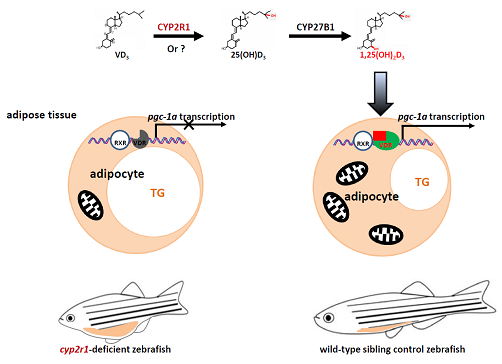
Newsroom
Vitamin D Promotes Fatty Acid Oxidation in Zebrafish Adipose Tissue
The ancient hormone Vitamin D3 is synthesized by a photochemical conversion process. The intact vitamin D (VD)/vitamin D receptor (VDR) system has been found in all vertebrates. The main function of VD/VDR signaling is well-recognized in the regulation of mineral homeostasis.
Over the last few decades, the relationship between the deficiency of VD/VDR signaling and adiposity has been suggested, based on observational and longitudinal cohort studies of various populations. However, the precise mechanism of the nonskeletal function of VD involved in adiposity has not been established at the cellular and physiological levels.
1α,25(OH)2D3 is the principal active hormonal form of vitamin D3 and is responsible for most of VD’s biological actions. The activation of Vitamin D3 from the skin involves two consecutive hydroxylation steps at C-25 and C-1α sites by 25-hydroxylases (for example, cytochrome C P450 member 2R1, CYP2R1) and 1α-hydroxylase (CYP27B1), respectively.
Initially, a Chinese research team led by Prof. YIN Zhan at the Institute of Hydrobiology of the Chinese Academy of Sciences discovered an inverse correlation between the plasma levels of 1,25(OH)2D3 and body lipid content during zebrafish development and aging.
In order to clarify the potential roles of 1α,25(OH)2D3 in lipid metabolism, two independent cyp2r1-depleted zebrafish mutant lines were generated by this research team using a genetic approach.
The cyp2r1-deficient fish– with 1,25(OH)2D3 plasma levels in the mutants about 32% of the level in the control siblings – exhibited obvious retarded somatic growth and increased accumulation of adipose tissue. This indicates a role for 1α,25(OH)2D3 in lipid mobilization as well.
Using the Chromatin Immunoprecipitation (ChIP)-PCR technique, genomic regulatory regions of peroxisome proliferator-activated receptor gamma, coactivator 1α (pgc1a), a gene involved in lipid metabolism, especially in mitochondrial function, was found to interact with VDR in zebrafish liver and visceral adipose tissues (VAT).
Researchers also found that the putative DNA-binding sites of VDR and retinoid X receptors (RXR) found in
The research confirmed significant reductions in the levels of mitochondrial biogenesis, mitochondrial membrane potential, and free fatty acid oxidation activity in cyp2r1-deficient VAT. Therefore, the results demonstrated the regulation of 1α,25(OH)2D3during lipid metabolism through the regulation of Pgc1a for mitochondrial biogenesis and oxidative metabolism in zebrafish VAT. The study was published in Cell Reports.
The study suggests a basal nonskeletal effect of ancient VD/VDR signaling in teleosts during early evolution, which may also shed light on the mechanisms underlying the relationship between the deficiency of VD/VDR signaling and adiposity that has been observed in mammals.
The study was supported by Ministry of Science and Technology of China, National Natural Science Foundation of China and Chinese Academy of Sciences.

Figure: The regulatory role of VD/VDR signaling in lipid metabolism in zebrafish (Image by YIN Zhan)